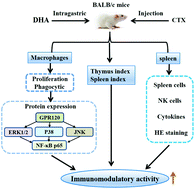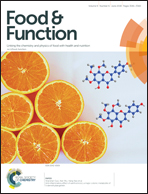The immunomodulatory activity and mechanism of docosahexenoic acid (DHA) on immunosuppressive mice models
Abstract
In this study, the immunomodulatory activity of docosahexaenoic acid (DHA) on the immunosuppressive BALB/c mice model and its molecular mechanism are elucidated. It was found that the weight indexes of the spleen and thymus were significantly increased by DHA (44.0 mg kg−1 and 88.0 mg kg−1) treatment in the prevention or cure groups. The result of macrophages showed that DHA (44.0 mg kg−1 and 88.0 mg kg−1) could promote the proliferation and phagocytosis activity of macrophages in the prevention or cure groups. In addition, DHA could activate macrophages by the G-protein coupled cell membrane receptor GPR120- Mitogen-Activated Protein Kinases (MAPKs)-nuclear factor κB (NF-κB) p65 pathway in vivo. The result of the spleen showed that DHA (44.0 mg kg−1 and 88.0 mg kg−1) could promote the proliferation of spleen cells and the natural killer (NK) cells activity in vivo. In the prevention or cure groups, the quantitative real-time polymerase chain reaction (qRT-PCR) results revealed that DHA (44.0 mg kg−1 and 88.0 mg kg−1) could enhance the production of cytokines IL-1β, IL-2, TNF-α and IFN-γ in the spleen of immunosuppressive mice. The HE (hematoxylin and eosin) stained histopathological images showed that DHA could repair the damage induced by CTX in the spleen cells of the prevention or cure groups. These results suggested that DHA has a remarkable immunomodulatory activity on the immunosuppressive mice model in the prevention or cure groups.



 Please wait while we load your content...
Please wait while we load your content...